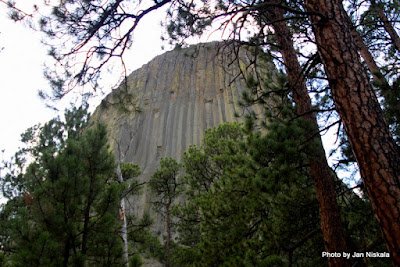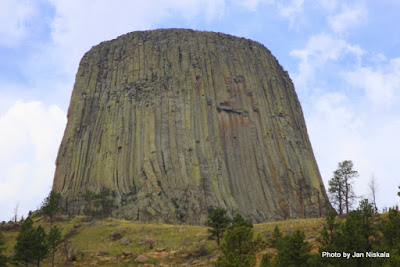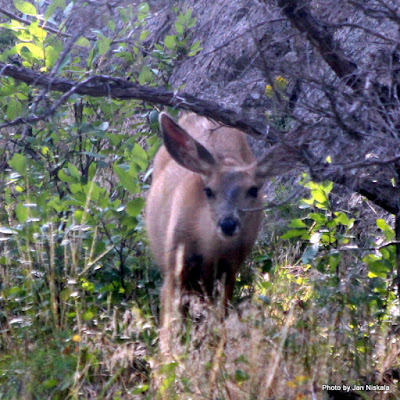Devil’s Tower National Monument & the Sturgis Motorcycle Rally
Devils Tower is a laccolithic butte
composed of igneous rock in the Black Hills in northeastern Wyoming. It rises
dramatically 1,267 feet above the Belle Fourche River, standing 867 feet from
summit to base. The summit is 5,112 feet above sea level. In the photo above you see only 4 of the rally cyclists ... but just wait!
Devils Tower was the first declared United States National Monument,
established on September 24, 1906, by President Theodore Roosevelt. The
monument's boundary encloses an area of 1,347 acres. The Sturgis Motorcycle Rally began August 14, 1938. There were literally thousands of cyclist! They were everywhere we went in this area as we visited!
Have you ever wondered how this rock tower was formed? No, I don’t believe the aliens did it!! But here are some geological explanations that might answer some questions.
Have you ever wondered how this rock tower was formed? No, I don’t believe the aliens did it!! But here are some geological explanations that might answer some questions.
The landscape surrounding Devils Tower is composed mostly of sedimentary rocks. The oldest rocks visible in Devils Tower National Monument were laid down in a shallow sea during the Triassic period, 225 to 195 million years ago. This dark red sandstone and maroon siltstone, inter bedded with shale, can be seen along the Belle Fourche River. Oxidation of iron minerals causes the redness of the rocks. This rock layer is known as the Spearfish Formation. We were not able to go down to the river the day we were there so no pics of those red and maroon rocks.
Created as sea levels and climates repeatedly changed, gray-green shale's (deposited in low-oxygen environments such as marshes) were inter bedded with fine-grained sandstones, limestone's, and sometimes thin beds of red mud stone. Resistant to weathering, it forms the nearly vertical cliffs which encircle the Tower.
Geologists Carpenter and Russell studied Devils Tower in the late 19th
century and came to the conclusion that it was formed by an igneous intrusion.
Modern geologists agree that it was formed by the intrusion of igneous
material, but not on exactly how that process took place. Several believe the
molten rock comprising the Tower might not have surfaced; others are convinced
the tower is all that remains of what once was a large explosive volcano.
Other theories have suggested that Devils Tower is a volcanic plug or that it is the neck of an extinct volcano. Presumably, if Devils Tower was a volcanic plug, any volcanics created by it – volcanic ash, lava flows, volcanic debris – would have been eroded away long ago. Some pyroclastic material of the same age as Devils Tower has been identified elsewhere in Wyoming.
The igneous material that forms the Tower is a phonolite porphyry intruded about 40.5 million years ago, a light to dark-gray or greenish-gray igneous rock with conspicuous crystals of white feldspar. As the magma cooled, hexagonal (and sometimes 4-, 5-, and 7-sided) columns formed. As the rock continued to cool, the vertical columns shrank in cross-section (horizontally) and cracks began to occur at 120 degree angles, generally forming compact 6-sided columns. Devils Tower did not visibly protrude out of the landscape until the overlying sedimentary rocks eroded away. As the elements wore down the softer sandstone and shale, the more resistant igneous rock making up the tower survived the erosional forces. As a result, the gray columns of Devils Tower began to appear as an isolated mass above the landscape.
Below are more photos taken on out drive to the Tower and while we hiked around the Tower. Enjoy!
 |
| Fields of sunflowers |
 |
| Someone couldn't decide what size to buy! |
Good bye to Devil's Tower!!
More coming soon!



















































No comments:
Post a Comment